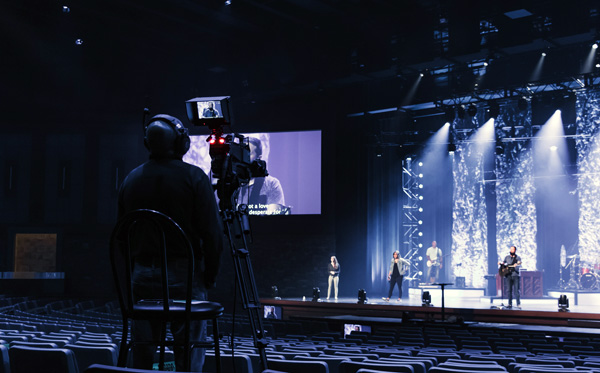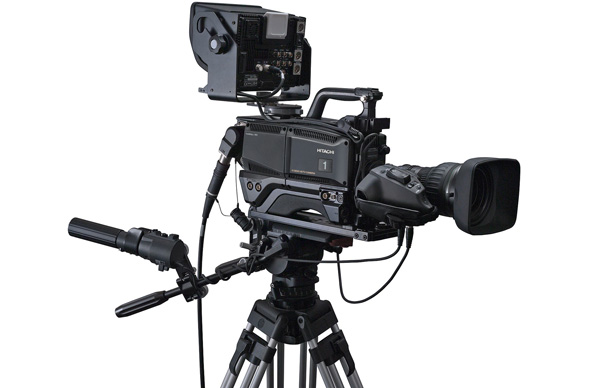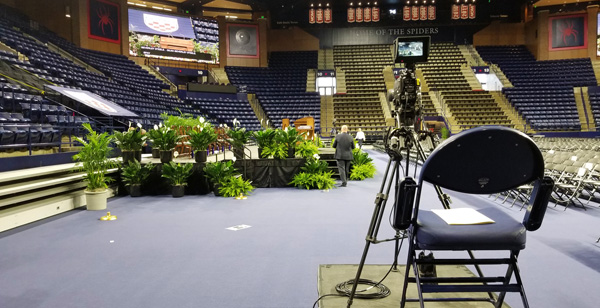
SK-HD1800 at Eastview Christian Church. (Photo credit: Noah Oehler)
Live steaming of events ranging from concerts to worship services is far from new, but the COVID-19 pandemic and resulting restrictions on in-person gatherings have thrust online video delivery into the spotlight.
When choosing technical systems for live streaming, a lot of attention is focused on the streaming encoder and delivery platform such as a CDN or social media channel – the last steps in the chain before the content reaches viewers. However, as John J Humphrey, Vice President of Business Development at Hitachi Kokusai Electric America, believes, while the cameras at the start of the chain are sometimes almost taken for granted, they make a huge difference to both the quality of the results and operational considerations. “Lower-end options ranging from smartphones and DSLRs to PTZ cameras and camcorders may seem attractive for their low cost, but broadcast-class cameras can significantly improve the look of your streams,” he said.
Compression vs Video Noise
As most video professionals already know, compression algorithms are used to reduce massive amounts of digital video data down to bitrates that comfortably fit consumer internet and mobile bandwidth. For example, 1920x1080 HD video at 30 fps may be streamed at a bitrate of 6.0 Mb/s – more than 240:1 compression compared to the 1.485 Gb/s of an uncompressed HD-SDI signal. Fortunately, modern compression algorithms such as H.264 can produce great-looking video at these bitrates, but achieving optimal results depends on the source signal the encoder receives.

Hitachi_SK-HD1800
“A misconception among many people new to streaming is that if you’re creating a low-bitrate output for viewing on a relatively small device – as opposed to a large-screen TV – you can get away with using a lower-quality source signal,” said John. “In fact, the opposite is generally true. Viewers are typically much closer to their smartphone, tablet, or laptop than they are to their TV, making visual imperfections noticeable despite the smaller screen size. Lower-quality sources also tend to have visual artefacts such as video noise that make the live signal much harder for the compression algorithm to process.
“At best, precious bits in the internet stream would be wasted representing the artefacts as well as the actual content, thus lowering the overall quality. At worst, the motion-sensitive nature of today’s compression algorithms can exacerbate the visual disruption the artefacts cause. Video that looks fine on a monitor connected directly to a camera can look considerably worse once compressed for streaming.”
Low Noise in Low Light
While some streaming encoders have video noise reduction features, such digital processing inherently has a negative impact on the quality and fidelity of the video. John said, “The best approach, of course, is not to try to ‘remove’ noise from the video – but to avoid video noise from the very beginning of the chain. Shooting video in low lighting conditions, which are common for many events such as music performances, can make issues with video noise even worse, and increasing the video gain to compensate can introduce considerably more noise into the image.”
This is one of many areas where broadcast-class cameras excel. In addition to offering significantly higher signal-to-noise ratios than lower-end alternatives, broadcast cameras – particularly those with multiple 2/3-inch image sensors – feature greater sensitivity that allows low-light environments to be captured with minimal or no gain adjustments even when moving quickly between well-lit and shadowed areas. Better low-light shooting is not just beneficial for streaming quality – it also produces a better visual experience for the audience by letting them see more detail even for subjects in darkened areas.

Z-HD5500 cameras from Hitachi Kokusai at Boitnott Visual Communications
Avoiding Artefacts
While video noise is a common acquisition challenge, other visual issues can be similarly disruptive to streaming compression. When capturing scenes with large LED displays in the frame, temporal artefacts such as flickering, horizontal banding and extraneous lines can appear in the video with cameras that use rolling-shutter MOS or CMOS image sensors.
“Once again, these moving artefacts can wreak havoc with compression algorithms, resulting in lower streaming quality, as well as visible distractions for in-venue viewers on IMAG screens,” said John. “Broadcast cameras with CCD or global-shutter CMOS image sensors can capture these types of situations while avoiding or greatly reducing LED-induced artefacts.”
Camera Operation
Apart from video quality benefits, broadcast cameras have significant operational advantages. Unlike a self-contained camcorder, a broadcast camera system combines the camera itself with a separate camera control unit (CCU), which is typically located in the production control room near the switcher. Combined with a remote control unit, this enables functions such as iris and shading to be adjusted by a technician in the control room, enhancing consistency between multiple cameras while freeing camera operators to concentrate on the actual shots. The availability of large viewfinders also makes it easy for operators to frame and focus their shots.
Broadcast cameras open valuable communication paths between the control room and camera operator including integrated intercom connectivity, return video and tally lights. Through the use of SMPTE Fibre connectivity between the camera and CCU, all of these functions plus program video, audio and even power can be carried on a single cable, which prevents the need for cumbersome multi-cable bundles and also supports much longer cable runs than SDI or HDMI.

John J Humphrey, Vice President of Business Development at Hitachi Kokusai Electric America Ltd
Last but certainly not least, broadcast cameras accept a large choice of industry-standard lenses, so that customers can choose the options that will best suit their environment and needs.
Affordable Broadcast Cameras
Small and mid-sized production companies may assume that broadcast-class cameras are beyond their financial means, but Hitachi Kokusai is making them more accessible to a broad range of producers. John said, “As a starting point, the Z-HD5000 is built with everything described above – excellent signal-to-noise and low-light sensitivity, three 2/3” sensors and rich operators features – at one of the best price/performance ratios available. For those who want native 1080p60 acquisition or global shutter CMOS sensors, the Z-HD5500 and SK-HD1800 deliver those features at a fraction of the cost of competing cameras in their class.” www.hitachi-kokusai.co.jp





